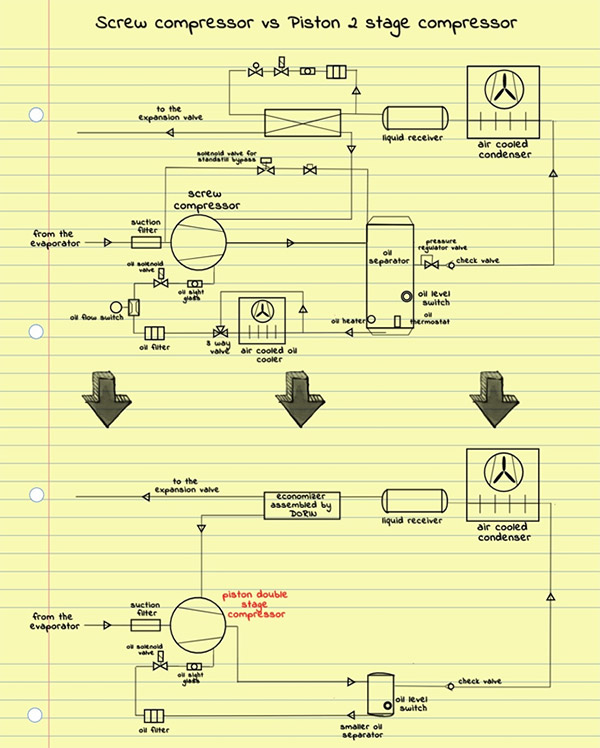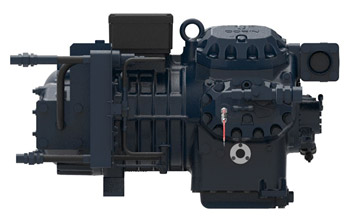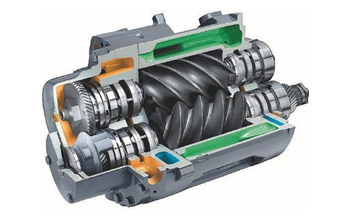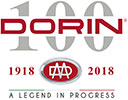
Here we analyze some efficiency and Capex aspects of industrial and semi-industrial applications in Low Evaporating temperatures
Which compressor type is the best?
Industrial applications usually necessitate of large cooling capacity and the common choice was for screw compressors because of their large displacement values.
From a technical point of view this is not always the best option... let's see why.
Technology intrinsic energy efficiency
Different compression technologies (mainly: scroll, screw, piston) show their best at very different optimum running conditions.
In the picture below it is reported the general isentropic efficiency behavior of the 3 different compression technologies in function of the pressure ratio (PR).
Typically, in low temperature refrigeration the PR is about 14, around this value the isentropic efficiency of piston compressors is showing the best values among screw and scroll.

First point: in screw compressors sealing and lubrication between the lobes is granted by a large oil flow (can be about 1800 lt / hr) and as the Pressure Ratio increases the sealing of the oil decreases causing gas by-passes from HP to LP sides and a lot of the motor energy is just used to heat up your POE oil the cooling of the oil becomes crucial to control the discharge temperature and the lubrication properties.
Second point: screw compressors usually have a fixed "internal volume ratio" (Vi) that cannot be changed as it is defined at the compressor design stage.
The internal volumetric ratio (Vi) is the ratio between the volume trapped between the 2 screws at the suction and the volume trapped at the end of the compression.
If your screw compressor fixed Vi corresponds to the real one (related to Pdisch/Psuct ) in your system that means you are a very lucky guy. Screws compressor usually perform an over-compression or an under-compression bringing to lower energy efficiency. Efficiency aspects, 50% saving
The graphic below shows a COP comparison between screw compressors with economizer and Dorin 2-stage piston compressors with sub-cooler. The comparison is at -45°C evaporating temperature and +50°C condensing temperature with R404A.
Covering the same cooling capacity of a screw compressor, the double stage can get almost double COP granting up to 50% energy savings for the end user.

Figure 3. COP comparison between Dorin 2 stage compressors and equivalent screw compressors @-45°C evaporating temperature and +50°C condensing temperature. Giving the same cooling capacity of a screw compressor, the efficiency of the 2-stage piston compressor is almost double than the screw. The smallest Dorin model in this comparison is 2S-H2000 on the left -, 20 HP electric motor and a displacement of 75.83 m3/h for LP (4 cylinders) and 37.91 m3/h for HP (2 cylinders) @50 Hz. The largest is 2S-H6500 on the right -, 65 HP electric motor and a displacement of 183.58 m3/h for LP (6 cylinders) and 61.19 m3/h for HP (2 cylinders) @50 Hz.
System cost aspects
As we said screw compressors are heating up a large quantity of oil when running in refrigeration conditions.
That means they need large oil separators, big oil coolers and 3 way valves to mix the oil at the tight temperature. Regarding new refrigerants like R449A (GWP: 1280 - AR5) or R448A (GWP: 1270 - AR5) discharge temperatures are even higher.
They also need an economizer to improve the efficiency in LT.
At the screw compressor start there is no oil pressure on the bearings so it is better to install a pressure regulator valve on the large oil separator to reduce the time the compressor runs without forced lubrication at the start.
Piston 2-stage compressors need simpler system, decreasing the complexity of the installation and the controls.
In the picture below there are two simplified schemes: one for the screw and one for the pistons, to briefly show the main differences between the two solutions.

Final conclusions
This comparison shows that the piston 2 stage compressor represents the best solution for most LT application both in terms of efficiency and cost/complexity of the refrigeration system. The Dorin new range of 8 cylinders 2-stage compressors is nowadays a valid alternative in terms of
Moreover, the unique design of the 2S range avoid all external pipes compared to other competitors' models; this special feature allows more compact external dimensions, an easy assembly of the sub-cooler kit and less chances of refrigerant leakages.

Which compressor type is the best?
Industrial applications usually necessitate of large cooling capacity and the common choice was for screw compressors because of their large displacement values.
From a technical point of view this is not always the best option... let's see why.
Technology intrinsic energy efficiency
Different compression technologies (mainly: scroll, screw, piston) show their best at very different optimum running conditions.

|

|
| Figure 1. The largest model of the 2-stage range, 2S-H6500, has a 65 HP electric motor and 8 cylinders. | Figure 2. Cutaway screw compressor. |
In the picture below it is reported the general isentropic efficiency behavior of the 3 different compression technologies in function of the pressure ratio (PR).
Typically, in low temperature refrigeration the PR is about 14, around this value the isentropic efficiency of piston compressors is showing the best values among screw and scroll.

First point: in screw compressors sealing and lubrication between the lobes is granted by a large oil flow (can be about 1800 lt / hr) and as the Pressure Ratio increases the sealing of the oil decreases causing gas by-passes from HP to LP sides and a lot of the motor energy is just used to heat up your POE oil the cooling of the oil becomes crucial to control the discharge temperature and the lubrication properties.
Second point: screw compressors usually have a fixed "internal volume ratio" (Vi) that cannot be changed as it is defined at the compressor design stage.
The internal volumetric ratio (Vi) is the ratio between the volume trapped between the 2 screws at the suction and the volume trapped at the end of the compression.
If your screw compressor fixed Vi corresponds to the real one (related to Pdisch/Psuct ) in your system that means you are a very lucky guy. Screws compressor usually perform an over-compression or an under-compression bringing to lower energy efficiency. Efficiency aspects, 50% saving
The graphic below shows a COP comparison between screw compressors with economizer and Dorin 2-stage piston compressors with sub-cooler. The comparison is at -45°C evaporating temperature and +50°C condensing temperature with R404A.
Covering the same cooling capacity of a screw compressor, the double stage can get almost double COP granting up to 50% energy savings for the end user.

Figure 3. COP comparison between Dorin 2 stage compressors and equivalent screw compressors @-45°C evaporating temperature and +50°C condensing temperature. Giving the same cooling capacity of a screw compressor, the efficiency of the 2-stage piston compressor is almost double than the screw. The smallest Dorin model in this comparison is 2S-H2000 on the left -, 20 HP electric motor and a displacement of 75.83 m3/h for LP (4 cylinders) and 37.91 m3/h for HP (2 cylinders) @50 Hz. The largest is 2S-H6500 on the right -, 65 HP electric motor and a displacement of 183.58 m3/h for LP (6 cylinders) and 61.19 m3/h for HP (2 cylinders) @50 Hz.
System cost aspects
As we said screw compressors are heating up a large quantity of oil when running in refrigeration conditions.
That means they need large oil separators, big oil coolers and 3 way valves to mix the oil at the tight temperature. Regarding new refrigerants like R449A (GWP: 1280 - AR5) or R448A (GWP: 1270 - AR5) discharge temperatures are even higher.
They also need an economizer to improve the efficiency in LT.
At the screw compressor start there is no oil pressure on the bearings so it is better to install a pressure regulator valve on the large oil separator to reduce the time the compressor runs without forced lubrication at the start.
Piston 2-stage compressors need simpler system, decreasing the complexity of the installation and the controls.
In the picture below there are two simplified schemes: one for the screw and one for the pistons, to briefly show the main differences between the two solutions.

Final conclusions
This comparison shows that the piston 2 stage compressor represents the best solution for most LT application both in terms of efficiency and cost/complexity of the refrigeration system. The Dorin new range of 8 cylinders 2-stage compressors is nowadays a valid alternative in terms of
- efficiency (up to half energy consumption than equivalent screws)
- lower system costs compared to screw compressors
- ... and easy maintenance and overhaul
Moreover, the unique design of the 2S range avoid all external pipes compared to other competitors' models; this special feature allows more compact external dimensions, an easy assembly of the sub-cooler kit and less chances of refrigerant leakages.

Categories








